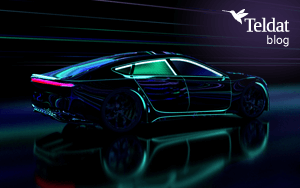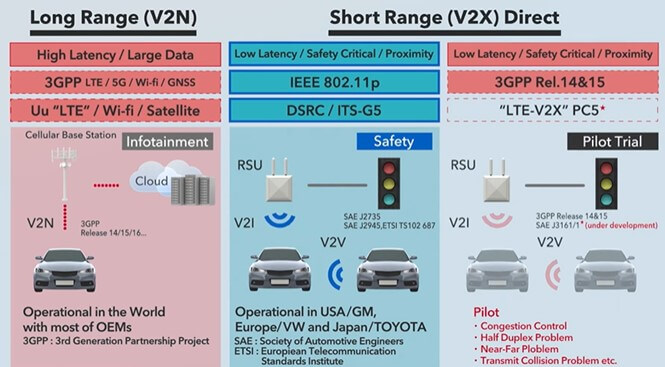 One day, Henry Ford said: “If I had asked people what they wanted, they would have said faster horses”. Twenty years later, horses had disappeared from the roads. Today, vehicles come with advanced safety, alternative fuels, and intelligent driving assistance packages. But what about the vehicles of tomorrow? Continuous improvements in 5G communications give rise to smart mobility, vehicle connectivity focused on greater road safety, a healthier environment, and a connected in-vehicle experience.
One day, Henry Ford said: “If I had asked people what they wanted, they would have said faster horses”. Twenty years later, horses had disappeared from the roads. Today, vehicles come with advanced safety, alternative fuels, and intelligent driving assistance packages. But what about the vehicles of tomorrow? Continuous improvements in 5G communications give rise to smart mobility, vehicle connectivity focused on greater road safety, a healthier environment, and a connected in-vehicle experience.
Future mobility
The European Union funds technological innovation to solve mobility problems that annually cause 2 million deaths and 35 million injuries. The EU promotes clean mobility through an organized, efficient, and digitalized system, with interoperable data exchange and standards.
Improved telecommunications connect autonomous vehicles to the relevant mobility and traffic agents. This connectivity requires a massive amount of data from multiple sources. This is where Big Data, the cloud and cybersecurity come in, analyzing, collecting, and protecting information from an infinite number of software and hardware units.
Future mobility communications
According to PWC, connected vehicles will generate a profit of $160 billion by 2030. V2X (vehicle-to-everything) communications are behind this boost, allowing vehicles to virtually connect with infrastructure, people, networks, and other vehicles. According to the US Department of Transportation, V2X must meet several requirements:
- Everything: if vehicles and infrastructures cannot communicate with each other, basic safety services will not work. This is why interoperable connectivity is necessary.
- Everywhere: vehicles travel everywhere, far beyond residential or urban areas (i.e., through mountains or tunnels where there is not as much infrastructure in place).
- Intergenerational: the average lifetime of vehicles is 12 to 15 years, so if new technologies replace each other, new vehicles and old vehicles will not be able to communicate with each other. This will require backward compatibility.
- Scalability: in order to avoid security risks, communications must be reliable (particularly in high-traffic scenarios).
ITS (Intelligent Transport Systems) communications have two main variants. Apart from V2X (vehicle-to-everything), there is V2N (Vehicle-to-network), where signals are transmitted via telecommunications networks. V2N is useful for sending large amounts of information to cloud services or traffic management centers. Hybrid communications result from combining these two technologies.
Source: V2X Supporters for Transportation Safety
The mobility solutions ecosystem
Through connectivity and a cloud-based interconnection system, urban traffic signaling could be streamlined, thus reducing delays. The technology used by vehicles will be able to accelerate or brake depending on the surrounding traffic. Semi-autonomous vehicles with Adaptive Cruise Control are an example of this promising function.
When it comes to heavy transportation, an increase in automation will create new business models for long-haul trucks, buses and the transport of goods and people. It will also give way to different technological players that will develop autonomous driving operating systems, generate intelligent mobility management platforms (which will facilitate better routes and prices), or process the Big Data received.
Streets will be redesigned to turn parking spaces into invented flexible pick-up or drop-off areas, create transient stops during peak hours, be commercially useful in the evenings, and become loading and unloading areas at night. Mobility hubs will emerge, bringing together different mobility options, and smart parking meters will also appear (tailoring their prices and timing to market demand in real time).
Cybersecurity and mobility
Can we handle security with so much digital disruption, and what could go wrong? Many challenges will arise with the increase of vulnerable infrastructures for which there would be no second chances in case of an attack. A holistic approach is therefore needed to address the problems that could arise in this ecosystem. As the interaction between vehicle and mobility system infrastructures increases, an “Internet of Vehicles” or “Internet of Mobility” network will be conceived allowing for certain road sections or vehicle fleets to be shut down in the event of hacking.
Conclusion
Transitioning to the mobility of the future will give rise to a large industry that could compensate for economic or employment losses. There are several market barriers to the adoption of automated and connected driving, mostly linked to safety and reliability. Connectivity solutions are a major key to the automated and cyber-safe driving system and are considered a priority among industry competitors.
Teldat has been developing special in-vehicle devices for years, and continues to search for new cybersecurity technologies and communication solutions that can be applied to vehicles.



























